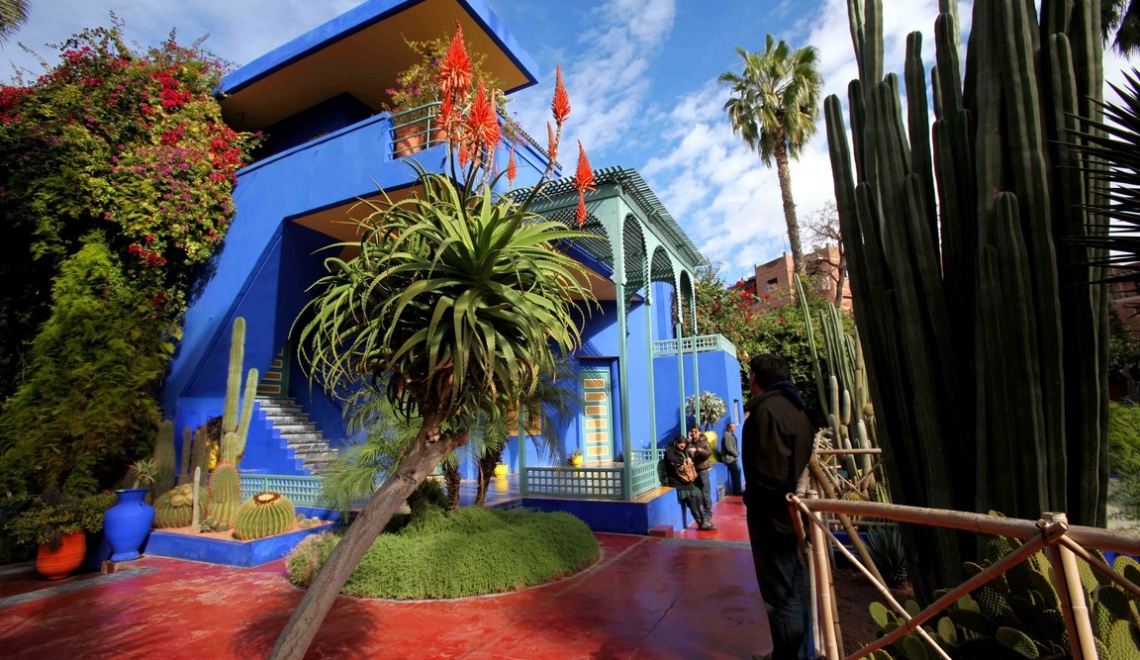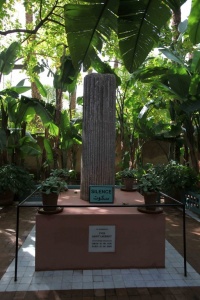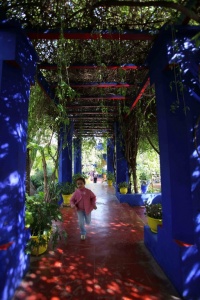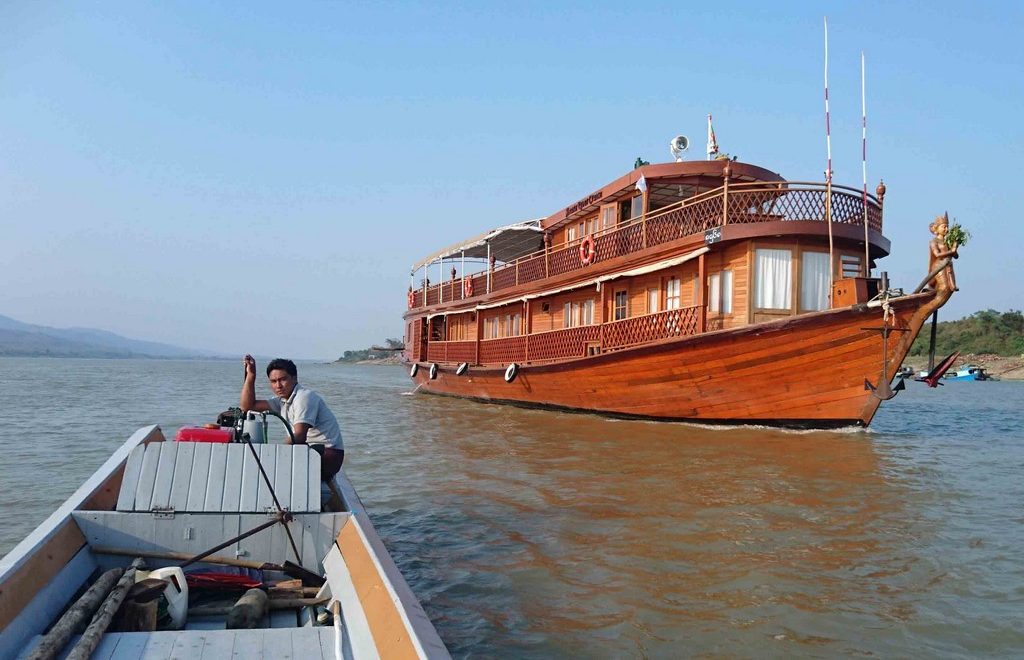
His name is forever linked to a colour, the deep cobalt blue that Jacques Majorelle, the visionary painter and gardener, painted on the walls of his villa-workshop in Marrakech in the early 1930s. And to an enchanting garden, the work of a lifetime. An oasis of rare essences, saved in 1981 from the property market by Pierre Bergé and Yves Saint-Laurent. To fulfil a painter?s dream.
The first time you enter this enclosed garden, in the image of Islamic gardens, you are surprised by the atmosphere of serenity and peace that pervades the place. Far removed from the hustle and bustle and bright lights of the ochre city. Only the rustle of a fountain or the song of a bird escapes from this mosaic garden, which Majorelle was to magnify by painting it like a canvas. Pergolas, fountains, jars, borders of paths and ponds, the walls of the villa-workshop: cobalt blue underlines these immobile outlines against which the green tones of the species and flowers from the five continents come to life.
"Voracious Ogre
In this oasis of greenery, which Majorelle continued to enrich until his death, tall trees - palm, pistachio, coconut and pomegranate - form a protective canopy against the scorching summer sun or the biting winter. We are at the foot of the High Atlas mountains, and the genius of this collector lies in his ability to protect the plant species from the extremes of temperature. Hundreds of species - cacti, yuccas, water lilies, water lilies, jasmines, bougainvilleas, palms, coconut palms, banana trees, euphorbias and bamboos - flourish in masterful harmony beneath the high foliage.
Opposite the house, a pond covered with water lilies, papyrus and lotus extends into a water path that opens onto the resting pavilion. From gutters to pools, from fountains to canals, water, the soul of the Islamic garden, mirrors the plants and brings a little freshness to the visitor. Over the years, the garden has been transformed and enlarged three times to reach four hectares. Nothing is too good for this little paradise on earth, "a voracious ogre on which I have been toiling for twenty-two years, and which would take another twenty years to make the angels of Paradise burst with envy", as Majorelle put it in 1945, shortly before an exhibition in Casablanca where he hoped to "rebuild his finances". Heavenly inspiration, but a titanic task that he pursued tirelessly! Majorelle painted so that his "earthly paradise" could continue to exist, and it was this garden that would ultimately bring his painted work to light better than anyone else.
The rescue
However, it was not until some twenty years after the death of its creator that the angels once again watched over the garden. Open to the public but abandoned, the place was frequented mainly by lovers who found refuge there and fishermen who cut bamboo to make fishing rods? In 1980, Yves Saint-Laurent and Pierre Bergé, until then visitors and admirers of the Majorelle garden, bought it, saving it from the property speculation that was undermining Marrakech?s heritage. The long months of restoration work that followed led, in January 2001, to the creation of the Association pour la Sauvegarde et le Rayonnement du Jardin Majorelle (Association for the Preservation and Promotion of the Majorelle Garden), thus ensuring its continued existence. The site has regained all its splendour. With a museum to boot. The Atelier Bleu, designed in 1931 by the architect Paul Sinoir, now houses a small museum of Islamic art. A showcase for the personal collection of Pierre Bergé and Yves Saint-Laurent, it features Islamic art objects from the Maghreb and the wider Orient. Ceramics, pottery, weapons and jewellery make up an extremely beautiful collection. There is also an area devoted to the painter Majorelle.
 Following the death of the famous couturier on 1 June 2008, a stele was erected in his memory in the Jardin Majorelle. The garden was donated by Yves Saint-Laurent and Pierre Bergé in the early 1980s to a British foundation, which is responsible for its upkeep. It is visited by over 600,000 people every year.
Following the death of the famous couturier on 1 June 2008, a stele was erected in his memory in the Jardin Majorelle. The garden was donated by Yves Saint-Laurent and Pierre Bergé in the early 1980s to a British foundation, which is responsible for its upkeep. It is visited by over 600,000 people every year.
A bit of history
Jacques Majorelle was born in Nancy in 1886. He was the son of the famous cabinetmaker Louis Majorelle. He came to Marrakech in 1917, fell in love with Morocco and in 1924 acquired a plot of land in the palm grove that was to become his garden, an Eden that he opened to the public in 1947. He died in France in 1962 of leukaemia and is buried in Nancy.
Visit
The Majorelle garden is open every day (opening times vary according to the season). Dogs and picnics are not permitted. A small café-restaurant serves Moroccan specialities, excellent cuisine and attentive service. Lovely terrace overlooking the garden.

Avenue Yacoub El Mansour
Marrakech
www.jardinmajorelle.com
Tel. (212) 5 24 31 30 47
Accommodation
The nomad villa
This is a pretty riad in the heart of the historic medina, with 12 rooms and suites spread over two levels and decorated in the purest Moroccan tradition. All different, they open onto a vast, bright patio planted with trees and offer the refinement of the purest oriental craftsmanship. They offer the utmost in comfort and service, guaranteeing an intimate atmosphere. The bathroom walls are covered in tadelakt. The riad is heated in winter and air-conditioned in summer. The restaurant is one of the best in Marrakech.
www.villanomade.com
www.vdm.com
Tel. 0892 23 73 73
Read
Un jardin à Marrakech, Jacques Majorelle, peintre-jardinier 1886 ? 1962, Alain Leygonie. Ed. Michalon.








This garden is a real bubble of calm and freshness in the heart of the Moroccan capital, which I really appreciated during my stay in Marrakech.